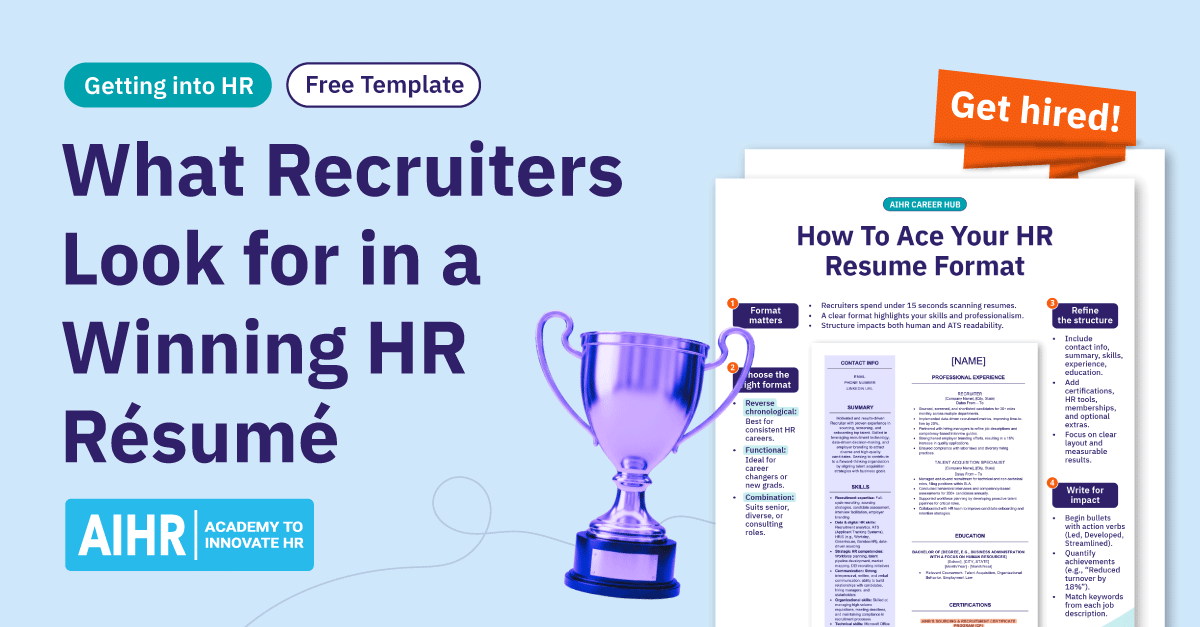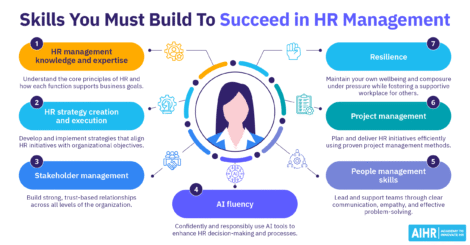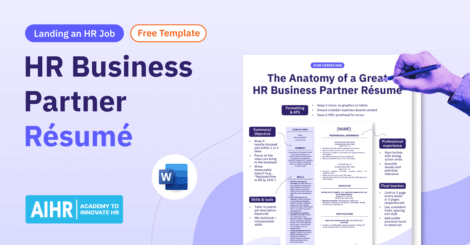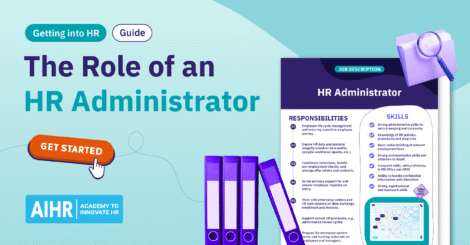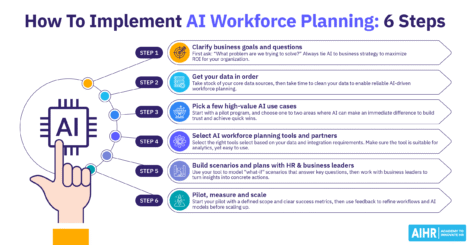Your HR résumé format is one of the most important tools you have when applying for a new role. In a competitive job market, where there is only a 1 in 17 chance that the résumé submitted will result in an interview, even highly qualified candidates can be overlooked if their résumé doesn’t meet recruiter expectations.
For HR professionals, your résumé isn’t just a personal introduction; it’s also proof that you understand what makes a candidate stand out. You’re not just applying; you’re demonstrating how you assess talent, present skills, and communicate effectively.
So, what do we mean when we talk about “format”? We don’t just mean Word vs. PDF. It’s about structure. Whether you use reverse chronological or functional layout, how you organize content, your use of headings, fonts, and whether the document is easy to scan, both for humans and for applicant tracking systems (ATS).
This article will guide you through the best résumé formats for HR professionals, when and why to use each one, and how to structure and present your experience to ensure your résumé works as hard as you do.
Contents
Why your HR résumé format matters
Choosing the best HR résumé format
HR résumé format structure
HR résumé format example
Tips for making your HR résumé format stand out
Key takeaways
- Recruiters scan HR résumés in 10 to 15 seconds, so the format must make key skills, experience, and achievements easy to find for both humans and ATS.
- You should choose the résumé layout based on your career story, seniority, and any gaps or transitions you need to de-emphasize.
- A strong HR résumé has clear core sections, including a professional summary, competencies, work experience with measurable results, HR tools, relevant memberships or extras, etc.
- Clean, ATS-friendly design and content choices significantly improve your chances of landing an interview.
Why your HR résumé format matters
When it comes to landing your next HR role, first impressions start long before the interview — they begin with your résumé. Job seekers know this and are investing heavily in their applications. According to the Employ Job Seeker Nation Report, 93% report putting a significant or moderate amount of effort into their job search, and over half regularly update their résumés and supporting materials. In fact, 66% of job seekers submitted over 50 applications within a period of three months or more.
Despite this effort, recruiters make decisions quickly. Nearly 42% of HR professionals spend less than 10 seconds reviewing a résumé, and almost 65% form a first impression in under 15 seconds. If they can’t find key information immediately, they move on.
That’s why the structure and formatting of your HR résumé is more than a design choice; it’s a strategic decision that can determine whether your application gets reviewed seriously or gets lost in the shuffle. The right format highlights your capabilities, presents your achievements clearly, and ensures your application is easy to read for both human recruiters and applicant tracking systems (ATS).
Let’s take a look at why your résumé is a strategic tool in career advancement:
- The right format highlights your marketable skills: The best résumé format for HR professionals immediately highlights your core capabilities, like employee relations, talent acquisition, or HR compliance. It showcases your strengths, making it easier for hiring managers to see why you’re a strong fit.
- Clarity and organization reflect your professionalism: Attention to detail and communication skills are critical in HR. A polished résumé format in Word or PDF signals your ability to present information clearly, a must-have quality in any HR role.
- Applicant Tracking Systems (ATS) prefer standard formats: Many companies use ATS software to screen résumés before a human reviews them. Choosing the best résumé format (a straightforward, text-based layout without heavy graphics) increases your chances of passing automated filters.
- Your format matches the role’s seniority: An HR Manager’s résumé in Word format might emphasize leadership, strategic achievements, and team management, while an entry-level HR officer’s résumé might focus on skills and certifications. The right structure helps you tailor your story for the target level, which tells the recruiter you understand what the role entails, you believe you are a good fit for it, and you aren’t wasting their time.
- It creates consistency across your application materials: If you’re uploading your HR résumé in Word and submitting a cover letter or LinkedIn profile, consistency in formatting, font choice, and structure reinforces a strong professional brand.
- It shows you value the recruiter’s time: HR professionals review hundreds of applications. A streamlined, easy-to-read format shows you value their time by making key information accessible, which is a small detail that makes a big impact.
Choosing the best HR résumé format
When it comes to advancing your HR career, your résumé is a strategic tool that can either open doors or leave you overlooked. One of the most important decisions you’ll make when writing your résumé is selecting the correct format.
While the reverse chronological résumé remains the most common choice, it’s not the only one available, and in some situations, alternatives like the functional or combination résumé could serve you better. Each format tells your career story differently, and the best choice depends on your work history, career goals, and the impression you want to make.
Choosing wisely matters. As we’ve highlighted, recruiters often scan résumés in 10 to 15 seconds, looking for immediate clarity on your skills, experience, and progression. A format that highlights your strengths while minimising potential concerns (such as career gaps or non-linear experience) can significantly improve your chances of making it to the interview stage.
As you consider your options, ask yourself:
- What story do I want this résumé to tell?
- Do I need to show steady progression, transferable skills, or diverse experience?
- Will this format be compatible for both humans and ATS systems?
Here’s how each format works and when to use it:
1. Reverse chronological résumé
This format lists your work experience from most recent to oldest, focusing on job titles, dates, and accomplishments in a clear timeline.
Pros:
- Highlights steady career growth and increasing responsibility
- ATS-friendly with standard headings and layout.
Cons:
- May draw attention to employment gaps or frequent job changes.
When to use it:
- You have a consistent work history in HR or a closely related field
- You want to showcase logical career advancement
- You are applying for traditional HR roles that value a proven track record.
Example in action
A candidate might list roles such as:
- HR Manager at ABC Corporation (2020–Present)
- Senior HR Advisor at XYZ Ltd (2017–2020), and
- HR Officer at DEF Pty Ltd (2014–2017).
Each role would include bullet points that highlight major achievements and responsibilities.
2. Functional résumé
This format focuses on skills and achievements rather than listing jobs by employer and date. Experience is grouped into skill categories such as Employee Relations or Recruitment and Talent Development.
Pros:
- Highlights transferable skills and expertise without drawing attention to career gaps
- Useful for career changers or new HR graduates.
Cons:
- Less compatible with ATS
- May raise questions for recruiters if the job history isn’t clearly laid out.
When to use it:
- You’re transitioning into HR from another industry
- You have significant gaps in your employment history
- You’re entering the HR job market for the first time after completing your studies.
Example in action
Instead of listing previous roles, a candidate could create a section like:
Talent management
- Led engagement initiatives that boosted retention by 15%.
- Collaborated with department heads to redesign onboarding processes.
Master the right skills and knowledge to boost your HR career
To get prospective employers to notice you, use continued learning to enable you to create a strong HR résumé and get closer to achieving your career goals
✅ Discover your HR-related strengths and see how they compare to those of your peers’
✅ Gain the skills you need to excel in multiple aspects of Human Resources
✅ Get the expertise to advance your career and make a lasting organizational impact
✅ Map your career path, set goals, and see which skills you need to grow professionally
🎓 Future-proof your HR career with Full Academy Access.
3. Combination résumé
A mix of the functional and reverse chronological styles, this format starts with a summary of key skills and achievements, followed by a shorter chronological list of previous roles.
Pros and cons:
- Showcases a broad range of skill sets while demonstrating career progression.
- Good for senior HR professionals, consultants, or those with diverse industry experience.
Cons
- Can become overly long if not carefully edited and focused.
When to use it:
- You have diverse experience across industries or contract work.
- You need to highlight a mix of skills and leadership achievements.
- You want to balance a skills focus with a clear employment history.
Example in action
An HR professional might begin with a “Key Skills and Achievements” section that covers HR Strategy, Technology Implementation, and Compliance, followed by a concise listing of past job titles, employers, and employment dates.
HR tip
Make your achievements measurable
Whenever possible, back up your claims with numbers. For example, saying you “reduced employee turnover by 18%” makes a much stronger impression than simply stating you were “responsible for employee retention.” Quantifiable results help recruiters see the real impact of your work.
HR résumé format structure
A well-structured résumé helps recruiters quickly understand your background and qualifications. Clear formatting and logical organization not only showcase your professionalism but also improve readability for both human reviewers and applicant tracking systems. Here are the essential sections to include:
Contact information
Place your full name, mobile number, email address, and LinkedIn profile at the top of the résumé. You do not need to include your full home address unless the job ad requests it.
Professional summary
Rather than an outdated objective statement, a professional summary introduces you to the reader. In two to four sentences, highlight your HR experience, key strengths, and what you bring to the role. This is your opportunity to create a strong first impression.
Core competencies or skills
Use relevant keywords to list your core HR competencies or technical skills in a separate section. Examples include talent acquisition, employee relations, HRIS systems, performance management, and compliance.
Work experience
List your work history in reverse chronological order, starting with your current or most recent role. For each position, mention your job title, the company name, dates of employment, and a short summary of your key responsibilities and achievements. Focus on quantifiable outcomes, such as “Reduced turnover by 15% through targeted employee engagement initiatives.”
Education and certifications
List your highest qualifications first: degrees, diplomas, HR certifications (e.g., Diploma in Human Resources Management, SHRM-CP, AHRI), and relevant studies. Include ongoing professional development if it supports your candidacy.
HR tools and systems
Highlight your experience with HR technologies like Workday, SAP SuccessFactors, BambooHR, or other HRIS platforms. This section is crucial for targeting roles in larger or tech-driven organizations.
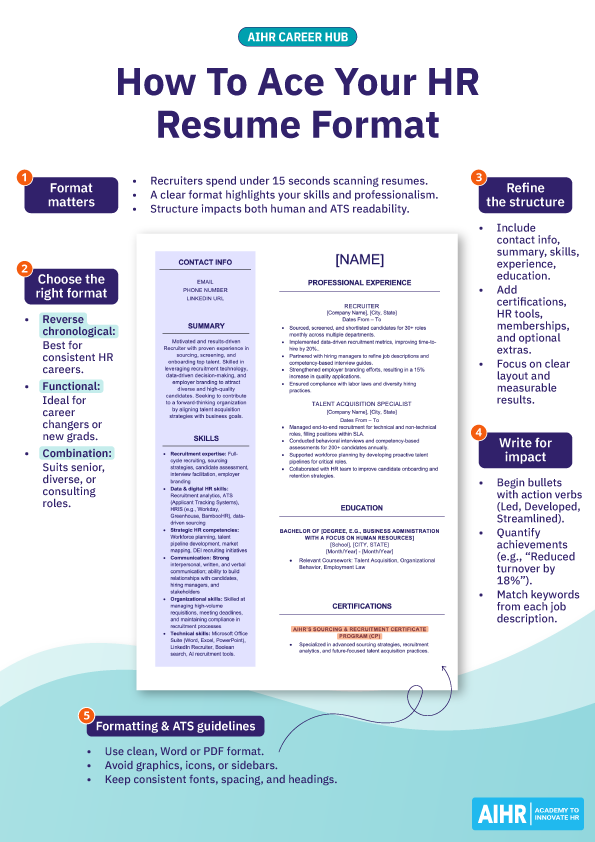
Professional memberships
Include this information if you’re a member of professional HR bodies like SHRM, AHRI, or CIPD. Memberships show your commitment to staying connected to HR and keeping your skills current.
Optional sections
Depending on your experience and the role you’re applying for, you may add extra sections:
- Awards: List any relevant professional awards or recognitions in your HR career.
- Publications: If you’ve written articles, whitepapers, or research papers in HR, mention them briefly.
- Volunteer work: Include relevant volunteer HR experience, community leadership roles, or nonprofit board positions.
HR tip
Think beyond job titles
When writing your professional summary and core competencies, avoid simply repeating your job titles. Instead, showcase key strengths, like “HR strategy,” “conflict resolution,” or “HRIS implementation”, that speak to your value across different organizations. This approach tells recruiters more about your capabilities and leadership style than a title alone.
HR résumé format example
If you’re creating your résumé from scratch or updating an existing one, using a clean, professional HR Manager résumé Word format can make all the difference. Below is a structured example you can follow or adapt to suit your experience. It includes all the essential sections recruiters expect and is designed to be both ATS-friendly and easy to read.

HR tip
Match your format to your career phase
Senior professionals often benefit from a combination résumé that balances leadership achievements with a clear employment history. Entry-level or transitioning candidates may find a functional format more effective for spotlighting transferable skills without highlighting limited experience. Choose the format that tells your story in the strongest possible way for the role you’re targeting.
Tips for making your HR résumé format stand out
A strong HR résumé format prioritizes structure, clarity, and measurable impact. Recruiters should be able to scan your résumé quickly and find relevant information without effort. Here are eight tips to help make your résumé stand out for the right reasons:
Tip 1: Use a reverse-chronological structure
This format is your safest and most professional choice. It puts your most recent role front and center, making it easy for hiring teams to track your career growth. Avoid functional or overly creative layouts unless you’re switching careers or addressing major gaps.
Tip 2: Limit it to one or two pages
A concise résumé demonstrates your ability to prioritize information effectively. Aim for one page if you have under 10 years of experience and no more than two pages for senior HR professionals or managers.
Tip 3: Stick to a clean, single-column layout
A single-column format makes scanning easier for Applicant Tracking Systems (ATS) and human readers. Avoid complex sidebars, multi-column designs, or graphic-heavy templates that may not upload well to job portals.
Tip 4: Use consistent headings and font styling
Professional consistency signals attention to detail, a critical skill in HR. Use the same font throughout, apply the same size and style to section headings, and ensure even spacing. If you’re creating your HR résumé format in Word, use styles to maintain consistency easily.
Tip 5: Avoid visual gimmicks
Charts, graphics, icons, and excessive colors may seem creative, but they confuse ATS software and distract recruiters. Stick to a classic design with white space, clear headings, and a strong focus on your achievements.
Tip 6: Prioritize readability over design trends
Your goal is to make your résumé easy to read quickly. Choose a professional font like Calibri, Arial, or Times New Roman, set clear section breaks, and use bullet points sparingly to highlight key accomplishments. A simple, clear HR manager résumé in Word format often outperforms trend-driven designs when applying for serious HR leadership roles.
Tip 7: Start each bullet with an action verb
Recruiters want to see what you did, not just what you were responsible for. Begin each bullet point with strong action verbs like “Led,” “Implemented,” “Developed,” or “Streamlined” to show initiative and impact. Follow it with specific outcomes whenever possible.
Tip 8: Tailor your résumé to each job description
A one-size-fits-all résumé won’t land interviews in competitive HR roles. Match the keywords, qualifications, and soft skills from the job ad to your résumé — especially in the professional summary and core competencies sections — to improve your chances of passing ATS filters and grabbing a recruiter’s attention.
To sum up
A polished, strategic résumé format is a must-have in any HR professional’s toolkit. It’s not just about aesthetics, but also about demonstrating to recruiters that you understand their priorities, respect their time, and know how to communicate clearly and professionally. By using a format that matches your experience level and presents your achievements in an accessible way, you significantly increase your chances of standing out in a crowded talent pool.
Whether you’re early in your HR career, looking to step into a senior leadership role, or transitioning from another industry, your HR résumé format can make or break your first impression. Choosing the right structure, tailoring your content to each role, and presenting your experience in a clean, ATS-friendly layout shows that you’re not only qualified but also ready to lead by example.



